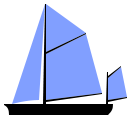Fateful Voyage
Glossary & Nautical Dictionary
Y
- yard
- W: A long tapered timber hung on a
mast to which is
bent a
sail, and may be further
qualified as a square, lateen, or lug yard. The first is hung at right angles to the mast, the latter
two hang obliquely.
- F: a long piece of timber suspended upon the masts of a ship, to extend the sails to the wind.
brace the yards
- yardarm
- TFD: Either end of a yard of a
square sail.
- yava
- See kava
- yaw
- W: A vessel's motion rotating about the vertical axis, so the
bow yaws from side to side;
a characteristic of unsteadiness.
- F: a name given by seamen to the movement by which a ship deviates from the line of her
course towards the right or left in steering.
- yawl

yawl
- F: a
wherry or small ship's boat, usually rowed by four or six oars.
- ye
- TFD: The. Misreading of ye, from Middle English þe, spelling of the, the (using the letter thorn).
Usage Note: In an attempt to seem quaint or old-fashioned, many store signs such as
"Ye Olde Coffee Shoppe" use spellings that are no longer current. The word ye in such signs looks
identical to the archaic second plural pronoun ye, but it is in fact not the same word.
Ye in "Ye Olde Coffee Shoppe" is just an older spelling of the definite article the.
The y in this ye was never pronounced (y) but was rather the result of improvisation by early printers.
In Old English and early Middle English, the sound (th) was represented by the letter thorn (þ).
When printing presses were first set up in England in the 1470s, the type and the typesetters all came
from Continental Europe, where this letter was not in use. The letter y was used instead because
in the handwriting of the day the thorn was very similar to y. Thus we see such spellings as
ye for the, yt or yat for that, and so on well
into the 19th century. However, the modern revival of the archaic spelling of the has not been
accompanied by a revival of the knowledge of how it was pronounced, with the result that (yē) is
the usual pronunciation today.
[Note: In the handwriting of documents on this site 'ye' is generally written 'ye' the same
as abbreviations like 'Modt for Moderate, but
as I have stated elsewhere, except in the official Bounty Logbook, I have omitted all these superscripts, both
to save myself some time and because it does not add to readability.]
- yeoman
- W: In a vessel of war, the person in charge of the storeroom.
- F: an officer under the
boatswain or
gunner of a ship of war, usually charged with the
stowage, account, and distribution of their respective
stores.



 W Home Glossary Z
W Home Glossary Z

 W Home Glossary Z
W Home Glossary Z